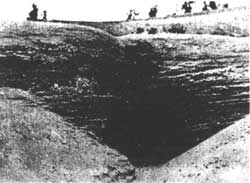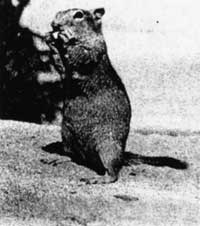Active Rock Slides
 Bedded Sands |
“Oh, look at the rocks tumbling down!” is a frequent comment of park visitors as they observe the rocks of the ancient Mazama rolling and bouncing down the caldera wall to a resting place in the waters of the lake.
There are many places along the inside wall of the volcanic caldera where active rocksliding constantly occurs. Near Chaski Bay and along the west section of the caldera by Wizard Island are some of the many places where large fan- shaped deposits consisting of various sized debris can be seen. The large gully-like depression immediately east of the Sinnott Memorial offers an excellent example of this process which is destroying the lake wall, making a very strong factor in its ultimate disappearance.
The walls of Mazama consist of volcanic fragmental and glacial debris, interbedded with well-fractured lava flows. The individual components, particularly of the first two members, are poorly held together and their unsupported ends incline at an angle of fifty or more degrees on the inside of the caldera.
Many factors contribute to the downward movement of the rock debris. Most important is melt-water derived from snow that accumulates to great thicknesses on the rock walls. This gives lubricating and hydraulic action for the removal of fine rock particles that support larger debris. Once a slide is started, more material of all sizes is dislodged along the paths. These tumble and bounce from one rock ledge to another, breaking off the edges, filling crevices crossed enroute, cutting their way through snow fields, and only slopping far below. Winds blowing against the walls also loosen fine particles which are supporting more massive material and help to start rock movement. Scurrying movements of small animals and tremblors caused by the rumbles of vehicles passing on the road, by thunder, or by distant slides are other contributing factors.
As rock slides and other forms of erosion transport material from the caldera wall to the bottom of the lake the caldera wall becomes lower and less steep; rock slides become increasingly less important. At the same time the accumulation of rock debris at the bottom of the caldera tends to fill the depression. Eventually, many thousand of years in the future, the lake will disappear by their combined action. Before the lake entirely disappears, the gradual reduction of the steepness of the caldera wall should result in the cessation of rock sliding as the more usual methods of erosion assume predominance.
Mammal Puzzles
Where did it come from?
 The mystery was deepened by the fact that the stranger appeared suddenly about the middle of August, and seemed to be quite tame. Visitors were happy over another animal which could be fed peanuts! On August 21, the little animal was brought to Park Headquarters for examination. In general appearance it was obviously a member of the ground-squirrel genus Citellus, but to what species did it belong? The body had no distinct pelage pattern; as had been described, the ears were very short, the feet quite large, and the tail short in relation to the body length.Not infrequently an animal is recorded from a locality where it has never before been known to occur. Such was reported by several members of the staff, Crater Lake Lodge employees, and some park visitors. Various descriptions were given of a strange creature living near the lakeside porch of the lodge. Descriptions were as varied as the number of reports, but all observers agreed that the new animal was squirrel-like in appearance, gray in color, very short-eared, and with a tail rather short for the body length. Some fantastic postulations were made, such as the possibility of a mutation of the golden-mantled ground squirrel, or of a hybrid between the ground-squirrel and the arboreal chickadee!
The mystery was deepened by the fact that the stranger appeared suddenly about the middle of August, and seemed to be quite tame. Visitors were happy over another animal which could be fed peanuts! On August 21, the little animal was brought to Park Headquarters for examination. In general appearance it was obviously a member of the ground-squirrel genus Citellus, but to what species did it belong? The body had no distinct pelage pattern; as had been described, the ears were very short, the feet quite large, and the tail short in relation to the body length.Not infrequently an animal is recorded from a locality where it has never before been known to occur. Such was reported by several members of the staff, Crater Lake Lodge employees, and some park visitors. Various descriptions were given of a strange creature living near the lakeside porch of the lodge. Descriptions were as varied as the number of reports, but all observers agreed that the new animal was squirrel-like in appearance, gray in color, very short-eared, and with a tail rather short for the body length. Some fantastic postulations were made, such as the possibility of a mutation of the golden-mantled ground squirrel, or of a hybrid between the ground-squirrel and the arboreal chickadee!
From a careful check on descriptions of Citellus in Anthony’s Field Book of North American Mammals (1928), and Bailey’s Mammals and Life Zones of Oregon (1936), this specimen can apparently be only C. oregonus (Merriam), the Oregon ground-squirrel. This knowledge, however, doesn’t explain how it came to occupy the vicinity of the lodge porch. This question of origin is particularly interesting in light of the fact that this is the first authentic record of this species in Crater Lake National Park.
Because the new visitor appeared suddenly, and was quite tame, it was probably brought in by a tourist. Whatever the cause of its arrival, it now is a permanent resident of the park zoological collection, available for reference and demonstration purposes.

